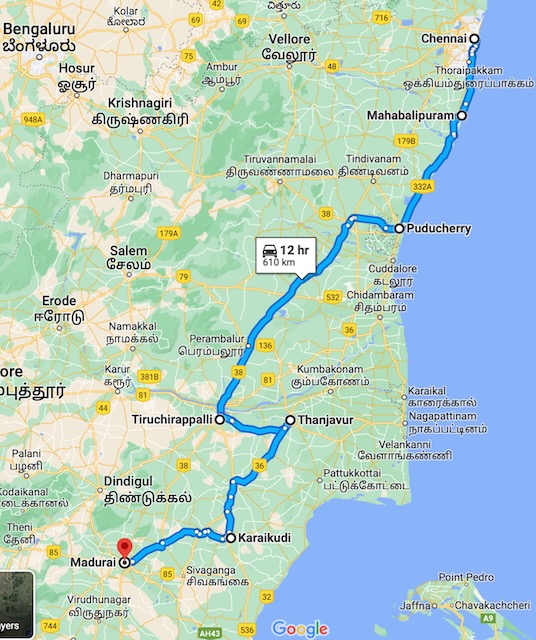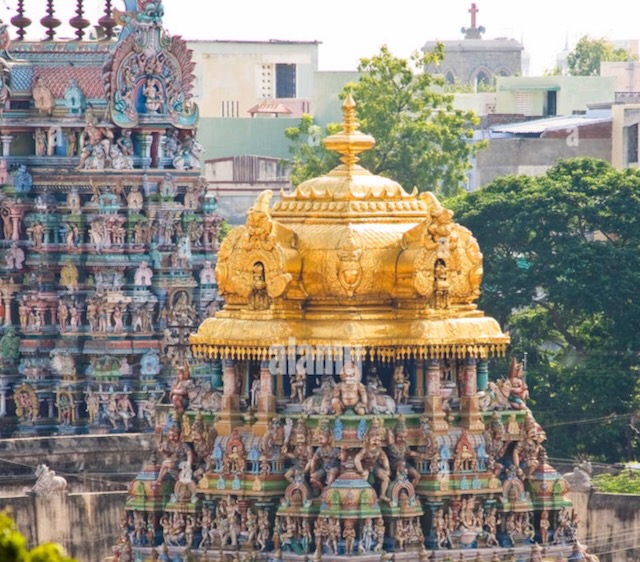
While Chennai (the old Madras) is the official capital of Tamil Nadu, Madurai is its cultural capital. It has a long and rich history, that goes as far back as the 3rd century BCE.
In ancient India, Madurai was known to trade with Rome, Greece and the Arab world some 500 years BCE. It exported spices, pearls, ivory, textiles and gems to these regions and imported gold, silver, wine, olive oil and pottery. Even though not on the sea, Madurai was well connected with a port called Korkai, on the Gulf of Bengal. From there, it could reach two main corridors to Europe: the Red Sea and the Persian Gulf. The Red Sea corridor involved transporting the goods by caravan across the Egyptian desert to the Nile, and then to the Mediterranean. The Persian Gulf corridor involved shipping goods to the Tigris and Euphrates rivers, and then transporting them by caravan across the Syrian desert, also to reach the Mediterranean.
The wealth and prosperity that such active trade created, inevitably attracted over the centuries many invaders and conquerors, both from inside India (the various Sultanates, the Vijayanagar (Hampi) empire, the Carnatic Kingdom etc.) as well as from outside India (The British East India Company in particular).
As a city, Madurai is different from other Tamil Nadu cities.
For one thing, it has been continuously inhabited for over 2,500 years. It is known as the “city that never sleeps”, because of its industriousness (it is today an important industrial and educational hub), its incredible lively street culture, as well as its tropical climate. It hosts many religious festivals and events throughout the year, which attract millions of people.
Madurai is also known as the “city of temples”, having many of these dedicated to various Hindu deities.
The Meenashki Temple
The most famous of these temples is the Meenakshi Temple, dedicated to Shiva and Parvati.
It is a marvel of engineering and artistic expression. It also dates back to more than 3,500 years ago, when they say the god Indra installed a small tower over a naturally formed stone lingam, as a sign of devotion to Shiva (one of the three primary deities in Hinduism). Since then, the temple has grown into a sprawling complex of 30,000 sculptures, 14 towering gateways, and dozens of shrines and halls. It is dedicated to the goddess Meenakshi, a form of Shakti (read divine feminine energy, an incarnation of Parvati, Shiva’s wife), and her consort Sundareshwarar, (read Shiva, the supreme male energy).
Every night, a strange ceremony takes place in the temple. It is called the “Going to Bed” ceremony. When I attended it, there were no less that 50,000 people in the temple that night, to witness this ceremony. The Brahmins priests go into Shiva’s temple, somewhere between 9 and 11pm, to pick him up and transport him on a palanquin. With lots of music and offerings, they transport him over to Meenakshi’s room, so he can spend the night with her. Meenakshi is Shiva’s mistress. Except she is not really, because in fact she is a reincarnation of his wife Parvati. What a great idea, an avatar of your wife. Note: it couldn’t be the other way round because, well, he is God you know. And every morning, the same Brahmin priests, pick him up at 5am, to bring him back to his own temple, to deal with the day’s business. I love the symbolism and humanity of all this, quite unimaginable in our misogynistic Catholic religion.

The temple has two gold plated domes, over the sanctums of Meenakshi and Shiva. The exact quantity of gold used for the plating of the domes is never mentioned, but it must be a considerable amount, given the size and height of those domes. The gold plating was done by a king of Madurai in the 17th century CE. These sanctums are inaccessible other than by the Brahmin priests. You can only see the gleaming gold domes from a couple of strategic places in the temple complex, far in the distance.
The temple has two other remarkable features.
One is the Hall of Thousand Pillars. It is simply a spectacular architectural piece that is said to have been built out of a single rock. The hall has 985 pillars, each hand carved with various sculptures of gods and goddesses out of hard granite blocs. In terms of human prowess, given the thousands of men and elephants it took to transport and sculpt these massive pillars, it makes Notre Dame Cathedral in Paris look like a side show in terms of human accomplishment.
The other remarkable feature are the musical pillars, located in that same hall. These pillars are made of granite and each one produces a different musical note when tapped. The pillars are arranged in groups of seven, representing the seven basic notes of Carnatic music. They are a testimony to the ancient Tamil science of acoustics (I will talk more about these when I cover Hampi).
Madurai Markets
Madurai is also known for its vibrant and colourful vegetable, fruit and flower markets. They are a feast for the eyes and the senses. They reflect a culture and tradition of the city’s people, who just love to adorn their temples and their homes with flowers.
Of particular note is the Mattuthavani Flower Market. This is one of the biggest flower markets in Tamil Nadu and transacts as much as 10 tons of flowers each day! There are over 100 shops on both sides of narrow lanes and it’s difficult to weave through masses of sellers, buyers and workers carrying heavy loads of flowers. The market is famous for its Madurai Malli (jasmine), which is a fragrant and delicate white flower that is highly valued for its unique scent and quality. Not to mention the other varieties of flowers like tuberose, rose, marigold, arali and picchi, all sold there.
The Central Market is a wholesale market for vegetables and fruits. The market has around 74 shops. The banana market in particular, which sells an incredible variety, is a sight to be seen. Before being sold, the bananas, having been picked green, are put into blackened backrooms where they are heated and smoked, to bring them to ripeness.
After spending three days in Madurai, I was, I confess, happy to leave the hustle and bustle of this amazing city. I found, at times, the incredible energy pulsing there, whether in the Meenashki Temple or the markets, to be rather overwhelming. I must be getting old ….

